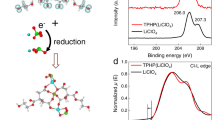Abstract
Polymer–inorganic nanocrystal composites1,2,3,4,5,6,7,8,9,10 offer an attractive means to combine the merits of organic and inorganic materials into novel electronic and photonic systems. However, many applications of these composites are limited by the solubility11 and distribution of the nanocrystals in the polymer matrices. Here we show that blending CdTe nanoparticles into a polymer–fullerene matrix followed by solvent annealing12 can achieve high photoconductive gain under low applied voltages. The surface capping ligand renders the nanoparticles highly soluble in the polymer blend, thereby enabling high CdTe loadings. An external quantum efficiency as high as ∼8,000% at 350 nm was achieved at −4.5 V. Hole-dominant devices coupled with atomic force microscopy images show a higher concentration of nanoparticles near the cathode–polymer interface. The nanoparticles and trapped electrons assist hole injection into the polymer under reverse bias, contributing to efficiency values in excess of 100%.
This is a preview of subscription content, access via your institution
Access options
Subscribe to this journal
Receive 12 print issues and online access
$259.00 per year
only $21.58 per issue
Buy this article
- Purchase on Springer Link
- Instant access to full article PDF
Prices may be subject to local taxes which are calculated during checkout




Similar content being viewed by others
References
Huynh, W. U., Dittmer, J. J. & Alivisatos, A. P. Hybrid nanorod–polymer solar cells. Science 295, 2425–2427 (2002).
Sun, B. & Greenham, N. C. Improved efficiency of photovoltaics based on CdSe nanorods and poly(3-hexylthiophene) nanofibers. Phys. Chem. Chem. Phys. 8, 3557–3560 (2006).
Han, L. et al. Synthesis of high quality zinc-blende CdSe nanocrystals and their application in hybrid solar cells. Nanotechnology 17, 4736–4742 (2006).
Zhou, Y. et al. Hybrid nanocrystal/polymer solar cells based on tetrapod-shaped CdSexTe1–x nanocrystals. Nanotechnology 17, 4041–4047 (2006).
Beek, W. J. E., Wienk, M. M. & Janssen, R. A. J. Efficient hybrid solar cells from zinc oxide nanoparticles and a conjugated polymer. Adv. Mater. 16, 1009–1013 (2004).
Mcdonald, S. A. et al. Solution-processed PbS quantum dot infrared photodetectors and photovoltaics. Nature Mater. 4, 138–142 (2005).
Qi, D., Fischbein, M., Drndic, M. & Selmic, S. Efficient polymer–nanocrystal quantum-dot photodetectors. Appl. Phys. Lett. 86, 093103-1–3 (2005).
Cui, D., Xu, J., Zhu, T., Paradee, G. & Ashok, S. Harvest of near infrared light in PbSe nanocrystal–polymer hybrid photovoltaic cells. Appl. Phys. Lett. 88, 183111-1–3 (2006).
Choudhury, K. R., Sahoo, Y., Ohulchanskyy, T. Y. & Prasad, P. N. Efficient photoconductive devices at infrared wavelengths using quantum dot–polymer nanocomposites. Appl. Phys. Lett. 87, 073110-1–3 (2005).
Greenham, N. C., Peng, X. & Alivisatos, A. P. Charge separation and transport in conjugated-polymer semiconductor–nanocrystal composites studied by photoluminescence quenching and photoconductivity. Phys. Rev. B 54, 17628–17637 (1996).
Huynh, W. U., Dittmer, J. J., Libby, W. C., Whiting, G. L. & Alivisatos, A. P. Controlling the morphology of nanocrystal–polymer composites for solar cells. Adv. Funct. Mater. 13, 73–79 (2003).
Li, G. et al. ‘Solvent annealing’ effect in polymer solar cells based on poly(3-hexylthiophene) and methanofullerenes. Adv. Funct. Mater. 17, 1636–1644 (2007).
Sze, S. M. Physics of Semiconductor Devices (Wiley, New York, 1981).
Caserta, G., Rispoli, B. & Serra, A. Space-charge-limited current and band structure in amorphous organic films. Phys. Stat. Sol. 35, 237–248 (1969).
Hiramoto, M., Imahigashi, T. & Yokoyama, M. Photocurrent multiplication in organic pigment films. Appl. Phys. Lett. 64, 187–189 (1994).
Reynaert, J., Arkhipov, V. I., Heremans, P. & Poortmans, J. Photomultiplication in disordered unipolar organic materials. Adv. Funct. Mater. 16, 784–790 (2006).
Marks, R. N., Halls, J. J. M., Bradley, D. D. C., Friend, R. H. & Holmes, A. B. The photovoltaic response in poly(p-phenylene vinylene) thin film devices. J. Phys. Condens. Matter. 6, 1379–1394 (1994).
Daubler, T. K. & Neher, D. Efficient bulk photogeneration of charge carriers and photoconductivity gain in arylamino–PPV polymer sandwich cells. Phys. Rev. B 59, 1964–1972 (1999).
Campbell, I. H. & Crone, B. K. Bulk photoconductive gain in poly(phenylene vinylene) based diodes. J. Appl. Phys. 101, 024502-1–5 (2007).
Sirringhaus, H. et al. Two-dimensional charge transport in self-organized, high-mobility conjugated polymers. Nature 401, 685–688 (1999).
Li, G. et al. High-efficiency solution processable polymer photovoltaic cells by self-organization of polymer blends. Nature Mater. 4, 864–868 (2005).
Choi, S. H. et al. Synthesis of size-controlled CdSe quantum dots and characterization of CdSe-conjugated polymer blends for hybrid solar cells. J. Photochem. Photobiol. A: Chem. 179, 135–141 (2006).
Schaller, R. D., Agranovich, V. M. & Klimov, V. I. High-efficiency carrier multiplication through direct photogeneration of multi-excitons via virtual single-exciton states. Nature Phys. 1, 189–194 (2005).
Dayal, P. B., Mehta, B. R. & Paulson, P. D. Spin–orbit splitting and critical point energy at Γ and L points of cubic CdTe nanoparticles: effect of size and nonspherical shape. Phys. Rev. B 72, 115413-1–6 (2005).
Soreni-Harari, M. et al. Tuning energetic levels in nanocrystal quantum dots through surface manipulations. Nano Lett. 8, 678–684 (2008).
Coe, S., Woo, W., Bawendi, M. & Bulovic, V. Electroluminescence from single monolayers of nanocrystals in molecular organic devices. Nature 420, 800–803 (2002).
Acknowledgements
H.-Y.C. and Y.Y. acknowledge financial support from Solarmer Energy (grant no. 20061880) and the Air Force Office of Scientific Research (FA9550-07-1-0264). Help from Hyun Cheol Lee for the TEM images and valuable discussions with Gang Li from Solarmer Energy are also highly appreciated. H.-Y.C. is grateful to Wei Lek Kwan and Bao Lei for helping with the transient measurements.
Author information
Authors and Affiliations
Contributions
H.-Y.C. conceived and performed the experiments and measurements. M.K.F.L. performed synthesis of CdTe nanoparticles and the capping ligands. G.Y. performed the AFM imaging. H.G.M. and Y.Y. conceptualized and directed the research project. All authors discussed the results and commented on the manuscript.
Corresponding author
Supplementary information
Supplementary Information
Supplementary Figures S1 – S2 (PDF 398 kb)
Rights and permissions
About this article
Cite this article
Chen, HY., Lo, M., Yang, G. et al. Nanoparticle-assisted high photoconductive gain in composites of polymer and fullerene. Nature Nanotech 3, 543–547 (2008). https://doi.org/10.1038/nnano.2008.206
Received:
Accepted:
Published:
Issue Date:
DOI: https://doi.org/10.1038/nnano.2008.206



